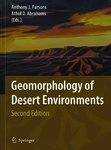Geomorphology of Desert Environments
Abstract
About one-third of the Earth’s land surface experiences a hyperarid, arid, or semi-arid
climate, and this area supports approximately 15% of the planet’s population. This
percentage continues to grow and with this growth comes the need to learn more about
the desert environment. Geomorphology is only one aspect of this environment, but
an important one, as geomorphic phenomena such as salt weathering, debris flows,
flash flooding, and dune encroachment pose major problems to desert settlement and
transportation.
The geomorphology of deserts has been the subject of scientific enquiry for more
than a century, but desert geomorphology did not emerge as an identifiable subdiscipline
in geomorphology until the 1970s when the first textbooks on the subject
appeared, namely Geomorphology in deserts in 1973 and Desert landforms in
1977. Also, in 1977 the Eighth Annual (Binghamton) Geomorphology Symposium
was devoted to the theme ‘Geomorphology in Arid Lands’ and the proceedings of
the symposium were published in the same year. The 1980s have seen the appearance
of titles dealing with particular topics within desert geomorphology, the most
notable of these being Urban geomorphology in drylands and Dryland rivers. As we
enter the 1990s, a new generation of textbooks on desert geomorphology has reached
the bookstores. Arid zone geomorphology and Desert geomorphology incorporate the
advances in knowledge that have occurred during the past 20 years but are primarily
written for the college student. By contrast, the present volume assumes that the
reader already has some knowledge of desert geomorphology. It is pitched at a level
somewhat higher than the standard text and is intended to serve mainly as a reference
book.

